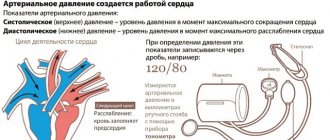Normal blood pressure readings, remaining within 120/80 mmHg, indicate the proper functioning of the body. In particular, about the absence of pathologies of the cardiovascular system and the good condition of the capillaries.
Regular jumps in tonometer readings, when they stabilize on their own, without the help of medications, doctors call blood pressure lability. This condition does not depend on age and is observed in both young and elderly patients. How to recognize the symptoms of labile blood pressure, what are the causes of the disease and what are the ways to combat it - we will discuss today.
Reasons for the development of the disease
Scientists still do not know the exact causes of PAH.
Factors that provoke pressure instability can be divided into congenital and acquired. In the first case, the tendency to the disease can be transmitted genetically or be provoked by intrauterine defects in the development of the myocardium, blood vessels, and kidneys. The acquired factors are diverse:
- overweight, obesity;
- hypodynamic lifestyle;
- diabetes mellitus, prediabetes;
- atherosclerosis, hypercholesterolemia;
- hypercalcemia;
- period of menopause, pregnancy;
- puberty;
- hormonal imbalance;
- lack of adequate sleep and rest patterns;
- abuse of caffeinated drinks;
- smoking, uncontrolled drinking of alcohol;
- the predominance of fatty, salty foods in the diet;
- mental and emotional instability, stress.
Labile arterial hypertension is recorded in people of different ages: children, adolescents, young, and elderly patients. This fact makes it even more difficult for specialists to find a single version that explains the development of pressure lability syndrome.
Symptoms
What do blood pressure readings of 190 over 110 mean?
Many people do not notice labile hypertension, since it may not manifest itself in any way. They seek medical help late, when it has already entered the initial stage of hypertension. You definitely need to monitor the slightest changes in your health.
Labile hypertension is characterized by the presence of the following symptoms:
- irritability and nervousness;
- numbness of fingers;
- mood swings;
- forgetfulness, inability to concentrate;
- pain in the back of the head;
- sleep disturbance.
In adolescence, labile arterial hypertension can occur against the background of the development of vegetative-vascular dystonia. It manifests itself as fatigue, chest pain, shortness of breath, and vomiting.
If such symptoms are detected, it is recommended to purchase a tonometer and begin monitoring your blood pressure throughout the day. An electronic device is more convenient when taking measurements yourself. Specialists carry out monitoring using daily pressure monitoring.
Phases
Labile blood pressure is divided into two phases:
Initial (Phase A). Blood pressure changes during severe overexertion of the body or during stress, but during normal times it remains within normal limits.
Transient (Phase B). Jumps in blood pressure occur much more often and are chaotic in nature, but the patient’s condition quickly returns to normal.
3 stages of labile blood pressure:
- Initial. It has a hidden course and no symptoms.
- Medium-heavy. It can be diagnosed according to the symptoms that appear and fade on their own.
- Heavy. Pressure surges are present quite often, and the symptoms are pronounced.
Symptoms of the disease
Reasons for blood pressure rising to 150
In addition to occasional increases in blood pressure, patients complain of the following ailments:
- the appearance of “flies” before the eyes;
- sleep disturbance and difficulty falling asleep;
- headache, which most often occurs in the occipital region;
- increased irritability, emotional instability;
- an occasional feeling of numbness in the limbs;
- decreased attentiveness and memory impairment.
If there is no treatment for labile blood pressure, these symptoms will gradually progress, significantly reducing the patient’s quality of life.
Causes of lability and correct definition of this condition
Many people are interested in whether labile blood pressure is a symptom or a disease? Since lability is a manifestation of a certain pathology, we can say that this state of blood pressure is a symptom. As mentioned above, sudden changes in blood pressure can cause hypertension, so this condition can be regarded as a symptom of hypertension.
Other diseases in which variable blood pressure is a symptom:
1. Vegetative-vascular dystonia
Since VSD often causes serious disturbances in vascular regulation, they may manifest as lability.
2. Diabetes mellitus
This disease affects the blood vessels, making the vascular system too sensitive to any influence, and blood pressure becomes variable.
Everyone knows that excess weight is an independent disease that entails multiple complications. These primarily include atherosclerosis and a tendency to hypertension, which causes unstable blood pressure.
These diseases most often cause labile blood pressure. However, there are some reasons that can also cause the development of this pathology:
- elderly age;
- hereditary predisposition;
- alcohol abuse;
- smoking;
- sedentary lifestyle;
- increased salt intake;
- high caffeine consumption;
- stress and frequent anxiety.
The first two reasons are universal and cannot be prevented. Fortunately, all other causes of the disease can be influenced from the outside by preventing variable blood pressure.
Lability of blood pressure leads to the fact that the patient occasionally experiences spasm in the arteries, which greatly worsens the patient’s condition
Important: this condition leads to a narrowing of the blood vessels, so strong pressure of the blood flow begins on their thin walls. Over time, blood pressure returns to normal and then changes again for some reason.
We can say that lability is one of the forms of hypertension, for which treatment is not necessary. But if the patient’s condition worsens, he will develop hypertension, for which appropriate treatment is prescribed. It will be in the interests of the patient himself to control blood pressure, which will improve the quality of life and allow him to maintain good health for a long time.
Classification by stages
Experts distinguish three stages.
Stage No. 1
Patients practically do not feel unwell. Only with a sharp change in mental state can unpleasant sensations occur. Most often, in the first stage, sudden surges in pressure affect the kidneys, brain, blood vessels in the eyes and liver.
The stage can last more than 25 years. This significantly increases the risk of developing cardiovascular diseases and stroke. If a heart attack occurs at this stage of lability, there is a high probability that it will lead to death.
Stage No. 2
During this period of development of the pathology, the symptoms may also be blurred, but when examining the patient, an elevated level of blood pressure is revealed, which is close to the indicators of hypertension.
Damage to internal organs occurs due to decreased muscle tone in the walls of the blood vessels of the heart.
At this stage, hypertensive crises are already possible. In a general urine test, the content of red blood cells increases. It is even possible that the normal functioning of the kidneys is disrupted.
Stage No. 3
Symptoms of the pathological condition are already clearly expressed. Sharp increases in blood pressure are common. The patient develops atherosclerosis of blood vessels. It disrupts normal blood circulation.
Treatment methods for labile hypertension
How to properly keep a blood pressure diary
A labile increase in pressure leads to very dangerous complications, so when the first symptoms of the disease appear, you should definitely contact a specialist. Doctors will conduct a thorough examination of the patient, diagnose the disease and prescribe treatment. As therapy, medication and folk remedies are prescribed, which are used at home. A dietary menu is also selected for each patient.
For high blood pressure levels, the following medications are used:
- Diuretic drugs - Furosemide, Veroshpiron.
- Calcium channel blockers - Verapamil, Diltiazem.
- Beta blockers - Metoprolol, Nebivolol, Bisoprolol.
- ACE inhibitors - Berlipril, Angiopril, Enalapril.
- Alpha adrenergic blockers - Doxazosin, Tamsulosin.
- Angiotensin II receptor blockers - Losartan, Candesartan.
- Magnesium preparations - “Magne B6”, “Magnerot”.
Traditional methods of treating labile blood pressure
A mustard-based foot bath will help normalize blood pressure.
For pressure lability, the following healer recipes are used:
- If your blood pressure rises, you should take a warm foot bath with mustard.
- Pour a glass of milk into a container, add 2 heads of garlic and cook. Use 1 tbsp. l. 3 times a day after meals for 2 weeks.
- Take one small onion, 4 cloves of garlic and finely chop everything. Pour everything with a liter of cold water, add 1 tbsp. l. dried rowan berries and boil for 15 minutes. Add parsley and dill to the resulting mixture, 1 tablespoon each, and boil again for 15 minutes. After this, let it sit for an hour. Take one and a half tablespoons 4 times a day, half an hour before meals. Use for 10 days. Repeated course of treatment - after 3 weeks.
- Take pomegranate peels and boil. Drink the decoction every day, a glass 2-3 times.
- Lingonberry juice effectively helps with labile blood pressure.
Dietary recommendations
Excluded from the diet:
- roast;
- fat;
- salty;
- spicy;
- smoked;
- alcoholic drinks;
- coffee and strong tea;
- flour products.
Recommended:
- dairy products;
- lean fish and meat;
- fresh vegetables and fruits;
- dried fruits;
- greenery;
- limit the amount of salt consumed (no more than 2 grams);
- drinking fluid at least 2 liters per day;
- whole wheat bread;
- soups and broths.
To increase the effectiveness of treatment for a disease such as labile hypertension, each patient is recommended to give up bad habits, lead an active lifestyle and sleep at least 8 hours. You also need to switch to proper nutrition, learn not to be influenced by stressful situations and monitor your weight. It is also recommended to take courses in therapeutic massage for the treatment of labile hypertension.
Emergency help at home
You can lower your blood pressure using basic means, without resorting to medications. A light massage of the collar area for 15 minutes will help improve blood circulation in the brain and relieve headaches.
Massage of the collar area will have a positive effect on blood pressure lability
Read more:Correctly measuring blood pressure
An effective method for lowering blood pressure is hand baths with hot water. It is enough to hold your hands in it for 10 minutes, and the condition will improve. Another proven remedy is apple cider vinegar, which is applied to the feet as a compress for 15-20 minutes.
A lemon-honey drink will bring relief; to prepare it, it is better to take non-carbonated mineral water. Add the juice of half a lemon and a teaspoon of honey to it. Stir, drink, the pressure will gradually drop.
The French have learned to treat hypertension with carrot tops, which are cut during flowering and dried. After this, it is brewed and drunk like tea; the drink should be consumed within six months. After a break of 2-3 years, treatment is repeated if necessary.
If the pressure has increased due to severe nervous shock, a saline dressing will help. Gauze or a towel is moistened in a 9% salt solution and placed in 3 or 4 layers on the lower back. You can secure the bandage with a bandage.
Medicines to control blood pressure should only be prescribed by a doctor.
Therapy
Treatment of labile hypertension is based on eliminating the root cause of the disease. Doctors recommend adjusting your lifestyle so that your blood pressure levels return to normal. If such methods do not help, medication may be required.
Rules:
- Do exercises or gymnastic exercises daily. Walking in the fresh air is also necessary. Swimming or jogging have a good effect on the cardiovascular system.
- Create a good emotional atmosphere in the home and workplace. Positive emotions have a great effect on health and vascular tone.
- Bad habits need to be completely removed from your life. It is acceptable to drink 50 grams of red wine once a week.
- The patient's diet must be balanced. The diet should be designed in such a way that it contains as many vitamins and useful elements as possible. Vegetables, fruits, lean meats and fish are necessarily included in the menu of such people.
- Drinks containing caffeine should be avoided.
- You need to sleep at least 8 hours at night. This will have a positive effect on the functioning of the entire cardiovascular system.
- Salt consumption should be limited. The permissible amount of sodium per day is 6-7 grams.
- Vascular tone can be maintained with a contrast shower. Such water treatments will strengthen the body's immune defense.
If a person suffering from labile hypertension is overly emotional or is often in stressful situations, then he needs to constantly drink sedatives. Medicinal herbs are suitable for treatment; they have no side effects and have a good effect on the nervous system.
Drug treatment is necessary if all other measures fail. Medicines for hypertension are prescribed in a complex manner, each of the medicines has its own effect on the body, which together brings tangible relief of the condition.
Groups of medications:
- beta blockers;
- diuretics;
- calcium antagonists;
- angiotensin receptor blockers;
- angiotensin-converting enzyme inhibitors;
- alpha-1-adrenergic receptor blockers.
Prescription of drugs should be carried out only by a doctor. The specialist will adequately assess the patient’s condition, carry out a set of diagnostic measures, after which therapy will be prescribed.
If blood pressure begins to rise, you need to immediately take measures to prevent it from reaching high and dangerous blood pressure readings.
How to quickly reduce blood pressure at home:
- Prepare a drink from lemon and honey. Add juice squeezed from half a lemon and 1 teaspoon of honey to a glass of mineral water. Stir and drink slowly. This will help the pressure decrease.
- Make a hand bath. Pour hot water into a basin at such a temperature that it is possible to hold your hands in it. Lower them there for 10-15 minutes, and the pressure level will decrease.
- When the blood pressure has increased due to stress, you need to apply a salt dressing. Prepare a 9% salt solution and moisten a piece of bandage with it. Apply a compress to the lumbar area and secure. Keep for about 2-3 hours.
To reduce the supply of nerve impulses to arteries and vessels, a person needs to take sedatives for a long time. For this purpose, doctors prescribe mild sedatives. This:
- "Novo-passit".
- "Glycine".
- "Sedavit."
- "Hawthorn tincture."
- "Glitsed" and others.
If all the doctor’s prescriptions and recommendations regarding the treatment of labile hypertension are followed, then there is a chance that the disease will recede. When the disease acquires a stable form, there is no need to talk about a complete cure. In this case, the disease becomes chronic and requires constant monitoring and adjustment of therapy.
You cannot ignore the symptoms of the disease; this will only accelerate the development of the disease. What is labile or essential blood pressure, and how to distinguish these types of hypertension, the doctor will tell you during a face-to-face consultation. It is impossible to diagnose the disease yourself.
Author of the article: Elena Vasilenko
Diagnostics
To identify the cause of the disease and prevent complications, in addition to constant blood pressure monitoring, additional diagnostics are important. A set of diagnostic measures is listed below.
Examination by a specialist
Labile blood pressure in the initial stage is usually asymptomatic, and late diagnosed hypertension is fraught with negative consequences. Timely and qualified diagnosis of the disease is very important. The specialist will perform an initial examination, measure blood pressure, and prescribe additional tests if necessary.
Examination by a specialist is included in the complex of diagnostic measures.
General blood tests (including biochemical), urine tests
To diagnose high blood pressure, the patient is referred for blood and urine tests.
The study will determine the levels of important indicators:
- hemoglobin;
- glucose;
- hematocrit;
- potassium;
- calcium;
- creatinine;
- blood lipid spectrum, including levels of HDL cholesterol, LDL cholesterol and triglycerides.
ECG
The doctor examines the heart muscle using a phonendoscope - listens to the heart rhythm and determines the presence of murmurs. Based on the results of physical diagnostics, the need for an ECG (electrocardiogram) is determined. This assessment of the work of the heart muscle is considered more detailed and allows timely detection of possible deviations. An ECG allows you to analyze the work of the heart in the most detailed manner in a given period of time.
Ultrasound
Ultrasound examination of the heart muscle also allows us to determine the condition of the heart, heart valves, the thickness of the walls, septa, and the presence of defects.
Ultrasound examination of the heart muscle can reveal the condition of the heart.
Vascular scanning
Dopplerography is an effective ultrasound examination that helps determine the state of blood flow through the vessels and the likelihood of their spasm.
Arteriography is an x-ray method that assesses the condition of arterial walls, “looks out” for atheromatous plaques and arterial defects in general.
Blood pressure monitoring
This procedure can be carried out either independently or while in a hospital under the supervision of a doctor. For the final diagnosis, the method of daily blood pressure monitoring (ABPM) is used. A portable device is installed on the belt, and a cuff is placed on the shoulder. Every 10-15 minutes during the day, half an hour at night, the cuff is inflated, and the device records the pressure reading. The patient can do his usual activities. This method allows you to measure blood pressure in natural human conditions.
Causes and symptoms of the disease
Labile arterial hypertension is generated by approximately the same reasons as hypertension:
- hereditary predisposition;
- bad habits (smoking, alcohol, overeating);
- sedentary lifestyle;
- improper diet;
- constant psycho-emotional stress;
- chronic kidney disease, diabetes.
A characteristic feature of this disease is that for a long time it may not manifest itself in any way - the person feels as usual, only the head may become a little “heavier”, which is perceived by most as ordinary fatigue.
If you do not pay attention and do not take measures, the disease will begin to develop, and after some time the following symptoms will appear: sharp pain in the occipital region, which appears quite rarely and disappears completely even without taking medications;
- insomnia, disturbing dreams that occur quite often;
- unexplained nervous tension;
- persistent changes in behavior: irritability, emotional outbursts and unexplained mood swings.
Advice
If you notice some or all of the above signs, try a simple experiment: measure your blood pressure with a home blood pressure monitor for 1 week, 3-4 times a day (upon waking, before bed and throughout the day at the same time) . Record all readings: If your blood pressure changes constantly throughout the day, it is very likely that you have labile hypertension. In this case, you should immediately contact a doctor, because the sooner you start treatment, the more effective it will be.
Peculiarities of manifestation of pressure lability
Floaters, irritability, memory loss are the first signs of the disease.
Patients complain of the following symptoms:
- intense pain in the back of the head;
- the appearance of irritability;
- memory impairment;
- sudden mood changes;
- sleep disturbance;
- the appearance of nightmares;
- the appearance of dizziness;
- “flies” before the eyes;
- discomfort in the heart area;
- rapid heartbeat;
- the appearance of shortness of breath;
- spasmodic pain in the chest area;
- loss of consciousness.
Return to contents
Causes of blood pressure instability
It should be noted that not everyone develops hypertension; only about 20% of people with a history of pressure surges are at risk. There is still no consensus among doctors about what factors are prerequisites for blood pressure lability.
Possible reasons include the following:
- Physical inactivity and excess weight lead to the accumulation of bad cholesterol, which impedes blood flow.
- Alcohol and cigarettes, which cause vasospasm - first temporary, and later taking on a chronic form.
- Large amount of salt in the diet.
- Excessive indulgence in caffeinated drinks.
- Psycho-emotional stress, nervous stress - they are especially often the ones that provoke instability of blood pressure in adolescence.
- Diabetes.
- Heredity. The presence of any form of hypertension in close relatives increases the risk of pathology.
Symptoms
The insidiousness of the disease lies in the fact that it can remain undetected for a long time. If treatment is not started on time, the disease develops, destroying all organs and systems of the body.
How it manifests itself:
- sleep disorders;
- pain in the head, often affecting the back of the head;
- nervousness for no reason, irritability;
- loss of sensation in the arms and legs;
- decreased concentration;
- flickering spots in the eyes;
- mild nausea.
If even one of the listed signs appears, a person needs to pay close attention to his health and be examined by a doctor.
To record blood pressure lability, it is necessary to measure this indicator 2-3 times a day, for 7-8 days. If an increase is detected once, then there is no talk of hypertension. Children are also susceptible to the disease, but identifying pathology in children is quite difficult. Usually the child complains of discomfort, pain behind the sternum, in the heart area, difficulty breathing or nausea. There are cases when labile hypertension is even accompanied by convulsive manifestations.
A hidden disorder sometimes indicates vegetative-vascular dystonia, which arose against the background of intensive growth of the child. If the disease affects children of primary preschool age, then symptoms are often absent. Often in children, a labile type of hypertension is a sign of delayed physical development, as well as possible heart failure.
Causes and treatment of emotional lability
A nervous system disorder can develop as a result of a variety of factors, including as a consequence of:
- Prolonged emotional stress: insufficient or excessive attention from others, a series of failures and stress, psychological trauma, constant prohibitions, etc.;
- Somatic disorder: lack of certain vitamins and minerals, hormonal imbalance, age-related hormonal changes.
Emotional lability can also accompany certain diseases:
- Hypertension or hypotension;
- Brain tumors;
- Atherosclerosis of cerebral vessels;
- Obliterating cerebral thromboangiitis;
- Organic brain damage;
- Asthenic conditions;
- Vascular diseases of the brain;
- Consequences of traumatic brain injuries.
In these cases, the disorder is seen as one symptom of another serious illness.
To treat emotional lability caused by emotional overstrain, you should seek help from a psychologist or psychotherapist. In all other cases, the first priority is to eliminate the underlying disease.
The doctor may also prescribe sedatives for emotional lability. If a person is experiencing anxiety attacks, tranquilizers may be indicated. If the patient is constantly depressed, antidepressants are used. Persons with a high level of excitability are prescribed a course of antipsychotic drugs for emotional lability.
Symptoms of the disease
In addition to occasional increases in blood pressure, patients complain of the following ailments:
- the appearance of “flies” before the eyes;
- sleep disturbance and difficulty falling asleep;
- headache, which most often occurs in the occipital region;
- increased irritability, emotional instability;
- an occasional feeling of numbness in the limbs;
- decreased attentiveness and memory impairment.
If there is no treatment for labile blood pressure, these symptoms will gradually progress, significantly reducing the patient’s quality of life.
Causes of lability and correct definition of this condition
Many people are interested in whether labile blood pressure is a symptom or a disease? Since lability is a manifestation of a certain pathology, we can say that this state of blood pressure is a symptom. As mentioned above, sudden changes in blood pressure can cause hypertension, so this condition can be regarded as a symptom of hypertension.
Other diseases in which variable blood pressure is a symptom:
1. Vegetative-vascular dystonia
Since VSD often causes serious disturbances in vascular regulation, they may manifest as lability.
2. Diabetes mellitus
This disease affects the blood vessels, making the vascular system too sensitive to any influence, and blood pressure becomes variable.
Everyone knows that excess weight is an independent disease that entails multiple complications. These primarily include atherosclerosis and a tendency to hypertension, which causes unstable blood pressure.
These diseases most often cause labile blood pressure. However, there are some reasons that can also cause the development of this pathology:
- elderly age;
- hereditary predisposition;
- alcohol abuse;
- smoking;
- sedentary lifestyle;
- increased salt intake;
- high caffeine consumption;
- stress and frequent anxiety.
The first two reasons are universal and cannot be prevented. Fortunately, all other causes of the disease can be influenced from the outside by preventing variable blood pressure.
Lability of blood pressure leads to the fact that the patient occasionally experiences spasm in the arteries, which greatly worsens the patient’s condition
Important: this condition leads to a narrowing of the blood vessels, so strong pressure of the blood flow begins on their thin walls. Over time, blood pressure returns to normal and then changes again for some reason.
We can say that lability is one of the forms of hypertension, for which treatment is not necessary. But if the patient’s condition worsens, he will develop hypertension, for which appropriate treatment is prescribed. It will be in the interests of the patient himself to control blood pressure, which will improve the quality of life and allow him to maintain good health for a long time.
What it is
Labile pressure is one that tends to rise or fall frequently, and stabilization of its indicators does not take much time. A person with this feature is considered healthy, but such changes must be controlled. Too sharp a jump in the indicator can affect the condition of blood vessels, and, accordingly, human health.
Stable blood pressure indicates normal heart function.
Treatment methods
It is important to begin treating labile (unstable) hypertension in the early stages. The success of therapy depends on the methods used
An individual treatment plan is drawn up for each patient.
Medicinal, traditional, and physiotherapeutic methods can be used. The maximum result can be achieved with an integrated approach to the problem.
An integrated approach is used in the treatment of unstable (labile) hypertension
It is important to follow the following treatment principles:
- accounting for concomitant diseases;
- selection of the dose of drugs depending on the age and characteristics of the body;
- control of laboratory parameters and monitoring of pressure during the therapeutic course;
- elimination of factors provoking the disorder.
In most cases, normalization of the condition is achieved by revising the lifestyle; experts give the following recommendations:
- reduce the salt content in dishes. You should consume no more than 3-4 grams per day;
- give up coffee, strong tea, alcohol;
- keep weight under control, do not exceed the norm;
- eat often and in small portions;
- exclude fatty foods, fast food, foods with preservatives and dyes from the menu;
- enrich the diet with vegetables and fruits;
- the daily energy value of the diet should not exceed 2000 kcal;
- sleep at least 8 hours a day;
- try not to worry about various topical situations;
- increase physical activity. Swimming, yoga, fitness, Pilates, and walks in the fresh air are useful. It is recommended to exercise three times a week.
But it happens that lifestyle correction is not enough to eliminate blood pressure lability.mob2
Doctors recommend using the following medications:
- Glycised;
- Glycide;
- tincture of motherwort, valerian or peony.
All these drugs have a sedative and vasodilator effect, help cope with stress, and improve sleep.
If the pathological process is severe and occurs on the border of transition to a chronic form, then antihypertensive drugs of the following groups are used:
- ACE inhibitors;
- beta blockers;
- calcium antagonists;
- diuretics;
- angiotensin receptor blockers two.
If pressure lability is caused by hormonal imbalances, then doctors select medications aimed at restoring balance.
The essence of folk methods is to use decoctions and tinctures prepared on the basis of medicinal plants. To treat pressure lability, rose hips, lemon balm, motherwort, hawthorn, and mint are used. Herbal therapy is effective, safe, but long-lasting.
Uneven heart pulse: non-pathological causes
Non-pathological factors can also be causes of an uneven heartbeat:
- low blood sugar;
- drinking coffee in large quantities;
- psycho-emotional disorders;
- low level of potassium in the body.
Most often, such causes are identified independently and do not require medical intervention for correction, but some can be diagnosed only after a full examination of the person.
Excess coffee
Coffee is high in caffeine, a substance that increases heart rate, increases blood pressure, and results in irregular heartbeat. If immediately after drinking such a drink a person notices a rapid heartbeat, then you should completely abandon it.
Additionally, it is recommended to limit the consumption of other drinks and foods that contain caffeine - green tea, energy drinks, chocolate. In this case, you need to stop taking medications with caffeine or reduce their dosage after consulting with your doctor.
As soon as your heart rate returns to normal, you can return to drinking coffee, but in strictly limited quantities - no more than 1 cup per 150 ml in the morning or before 16-00.
Lack of sugar
If cardiovascular pathologies are excluded, then an uneven pulse may be evidence of low blood sugar. In this case, you should not consult a doctor, but you definitely need to adjust your diet:
- take at least 5 meals a day;
- In the morning, eat complex carbohydrates - oatmeal, buckwheat or lentil porridge.
There is no need to increase the amount of sugar in drinks and dishes - this only leads to obesity, but not to the normalization of heart rate and evenness.
Psycho-emotional disorders
Psychological problems are considered the most common causes of an irregular pulse if pathological conditions are excluded after examination. Stress and emotional experiences lead to the fact that the heart begins to beat too fast, sometimes “freezing.”
You can restore the frequency and fullness of the pulse with sedatives and calming drugs. But their use must be agreed with a doctor. For example, Glycine can help solve the problem, but for a quick recovery it is worth taking drugs like Glycine forte, Glycised, which are characterized by a high concentration of the main active ingredient and the presence of a complex of vitamins.
Low levels of potassium in the body
Potassium is necessary to strengthen the walls of blood vessels and the nervous system; this substance is literally an anti-stress. If not enough of it enters the body, then an excessively rapid heartbeat and uneven pulse appear. Normalizing the condition is quite simple, you need to introduce into the diet:
- bananas;
- buckwheat porridge;
- apricots, fresh or frozen, canned;
- low-fat fish.
Sometimes a course of therapy with vitamin-mineral complexes that contain potassium is required. But first you will need to consult with a physician or cardiologist to get prescriptions regarding the daily dosage, the name of the specific drug and the duration of use.
Harmful and healthy foods
Do not forget about the basic principles of nutrition - it should be fractional and balanced. In order not to suffer from sudden surges in blood pressure, it is necessary to limit the consumption of salt and foods that contain a lot of it. The following types of food are considered harmful:
- flour products, especially fresh bread and pastries;
- smoked and fried foods;
- sweet soda, coffee;
- meat and mushroom broths, as well as soups made from them;
- fatty fish and meats;
- pickled vegetables, spicy snacks;
- offal.
To normalize blood pressure and strengthen blood vessels, the following products are recommended:
- porridges and soups with milk;
- vegetable salads and greens;
- fermented milk - fermented baked milk, cottage cheese, yogurt;
- chicken, turkey or rabbit - boiled, steamed or baked;
- dried bread, crackers.
People with labile blood pressure are considered absolutely healthy, but preventive measures are necessary to prevent a more serious disease - hypertension. The right combination of healthy foods, moderate physical activity and proper rest will help avoid problems with blood pressure and various complications.
Do they take you into the army?
The disease is a mild form of hypertension and is characterized by a short-term increase in blood pressure, therefore, when diagnosed with labile arterial hypertension, one is drafted into the army. If the disease has reached a chronic stage and the elevated blood pressure is permanent, then after examination the teenager is diagnosed with hypertension.
The disease is, of course, serious, but if you follow the doctor’s recommendations, the prognosis is favorable. A timely course of therapy prevents the risk of developing various pathologies. If everything is done correctly, the probability of developing hypertension is less than 20%.
Features of the pathology
Labile arterial hypertension is a disease characterized by increased blood pressure. The tonometer reading can change several times a day, and a specific increase in pressure is observed only occasionally. The difficulty in diagnosing this disease lies in the instability of its manifestations.
Arterial hypertension can be essential, in which blood pressure constantly rises, but there is a labile form of this disease, characterized by a temporary increase in tonometer readings.
The patient requires treatment in both cases, because disorders provoke serious pathological processes throughout the body. Labile blood pressure can cause unpleasant symptoms, but often they manifest themselves mildly and are more like overwork. Statistics show that more than a third of all cases of hypertension are labile - pressure sometimes rises and becomes normal on its own.
Due to the fact that people do not consult a doctor on time, attributing ailments to fatigue, arterial hypertension takes on an essential form.
Blood pressure readings may rise and become normal again for other reasons, not necessarily pathological. Some factors provoke growth at such a level that it is not considered a disease. This:
- sudden fear or fright;
- drinking drinks containing caffeine;
- excitement;
- physical activity;
- consumption of alcoholic beverages;
- smoking tobacco and more.
If the pressure has increased for one of the above reasons, then the person does not require treatment; the influence of these aspects should be reduced as much as possible. But more often, labile hypertension occurs due to disorders existing in the patient’s body.










